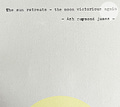This week I shared a bunch of forms so here is a more in-depth look at them
Kimo Poetry
Kimo poetry is the Israeli version of haiku. The language requires more syllables than typical haiku because I am presuming they use more syllables for words but don’t quote me on that as I do not speak it. The certainties around Kimo poems, however, are as follows. Th…
Keep reading with a 7-day free trial
Subscribe to mind noise by ash raymond james to keep reading this post and get 7 days of free access to the full post archives.


